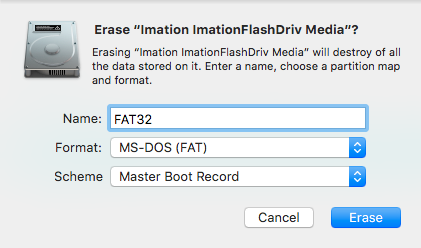

- #Making bootable usb os x gpt or mbr install#
- #Making bootable usb os x gpt or mbr full#
- #Making bootable usb os x gpt or mbr software#
- #Making bootable usb os x gpt or mbr code#

While not enthusiastically embraced by the Linux kernel developers, it offers some advantages over legacy BIOS and is becoming more widely used, especially for 64-bit x86 systems. The Extensible Firmware Interface is a BIOS replacement originally developed by Intel® for its Itanium® systems and later expanded to include x86 and other architectures. Virtualized systems (vmware, qemu, etc.) typically have their own legacy BIOS implementations and will use this method to boot Chromium OS images. We have a tool and scripts that can change the boot partition GUID in the MBR when we need to select an alternate boot path. The second-stage syslinux bootloader is installed on that partition, along with its corresponding config file (/syslinux/syslinux.cfg).
#Making bootable usb os x gpt or mbr code#
That code can specify one GPT partition to boot, indentified by a matching UniquePartitionGUID field in the Partition Entry Array. The Chromium OS build process places GPT-aware boot sector code from syslinux in the MBR. Legacy BIOSes will continue to boot Chromium OS from the MBR.

The first part of the kernel then switches to protected mode and jumps to the kernel's 32-bit entry point, passing along the pointer to the zeropage table. At this point, the CPU is still running in Real Mode. After the zeropage table is filled in, a pointer to it is placed in the ESI register and execution continues with the first part of the kernel. It also creates a special table in memory called the “zeropage table.” The bootloader initializes fields in that table by making calls to the BIOS via interrupts.
Eventually, the bootloader code identifies the kernel. That code then continues the boot process in some unspecified way - typically that VBR code (as well as the MBR code) is generated by and installed by grub, lilo, syslinux, or some similar bootloader. It searches the four partition table entries, finds a partition flagged as bootable, copies the first 512 bytes from that partition (the so-called Volume Boot Record or VBR) into RAM, and jumps there. Those first 440 bytes of MBR code are responsible for bootstrapping the rest of the OS. BIOS copies this block into RAM and starts executing the first byte. This consists of 440 bytes of real-mode code, 6 ignored bytes, 4 instances of 16-byte primary partition records, and 2 signature bytes, 0x55 and 0xAA. The BIOS looks at the first block of each drive until it finds a Master Boot Record (MBR). Legacy boot for x86 Linux has three steps: But as with any other GNU/Linux system, the pre-kernel boot process is unavoidably dependent on the hardware, BIOS, and bootloader. We want to make as few modifications to the upstream kernel as possible, ideally none. Provide a secure and verifiable boot path for official Google Chrome OS devices.Ĭhromium OS is essentially a specially-tailored GNU/Linux distribution. Support a limited selection of off-the-shelf netbooks for internal trials of Chromium OS. #Making bootable usb os x gpt or mbr software#
Support readily available development platforms so that Chromium OS software can be built and tested without waiting for final hardware/firmware. Goals for the boot process are as follows: Openness - Allow developers to run operating systems other than Google Chrome OS. Robustness - Recover from failed updates or corrupt partitions.  Speed - Support fast boot, where the boot loader is part of the firmware. Goals for the drive partitioning scheme are as follows: Set Launch CSM to Enabled.This document describes the layout of data on the disk drive for a Chromium OS device and the process by which the OS is booted. Boot the system into the BIOS (for example, using F2 or the Delete key).
Speed - Support fast boot, where the boot loader is part of the firmware. Goals for the drive partitioning scheme are as follows: Set Launch CSM to Enabled.This document describes the layout of data on the disk drive for a Chromium OS device and the process by which the OS is booted. Boot the system into the BIOS (for example, using F2 or the Delete key). #Making bootable usb os x gpt or mbr install#
Connect a USB Windows 10 UEFI install key. Consult with your motherboard or system manufacturer for specific BIOS instructions. Screenshots and directions below are examples. #Making bootable usb os x gpt or mbr full#
If you have a second disk drive with enough available capacity, you can create a system image and recover the full installation as it was before you started this procedure.
We highly recommended performing a backup of your data. System acceleration with Intel® Optane™ memory is not available when using MBR.Ĭonfigure a system to install an OS to a GUID Partition Table (GPT) partition Note Some features may not be available if you use the Master Boot Record (MBR) style partition table. We recommend performing Windows® 10 installations enabling UEFI with a GUID Partition Table (GPT).








 0 kommentar(er)
0 kommentar(er)
